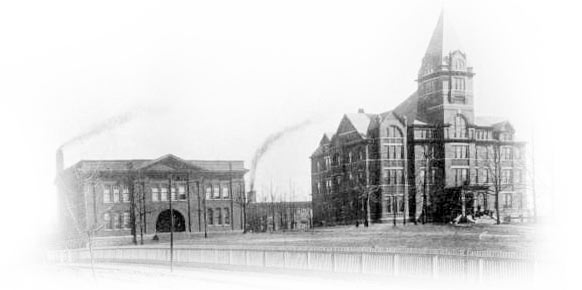#213 George W. Woodruff School of Mechanical Engineering
1888
Leader in transforming mechanical engineering education from a shop-based, vocational program to a professional one built on rigorous academic and analytical methods
Between its opening in 1888 and the mid-1920s, Georgia Tech took a leading role in transforming mechanical engineering education from a shop-based, vocational program to a professional one built on rigorous academic and analytical methods.
Led by John Saylor Coon (1854-1938), a founding member of ASME, this curriculum merged theoretical understanding with practical experience. By bringing Coon on board so soon after the school's founding, Tech began this transition almost from day one, even though it took three decades to completely effect it. Except for schools starting an engineering school after WWII, Tech may be unique in starting to chart a difficult new course essentially from the school's inception.
During the years after the U.S. Civil War (1860-64), industrialists recognized that recovery and expansion would depend heavily on professional engineers rather than machinists. A rational education in mathematics and science as applied to the problems in machines and processes was needed, and similarly, ASME's own beginnings in 1880 reflected this move toward professionalism. Georgia Tech was founded in 1885 to address the training of engineers, particularly important during the reconstruction of the devastated region. Their first degree was in mechanical engineering.
Debates on the role of the mechanical engineering occurring within ASME had a profound impact on Georgia Tech under John Saylor Coon's stewardship. Dr. Coon, himself a master technician who was a practicing mining engineer and steam-engine efficiency expert, had a keen sense of the role of scientific rigor in engineering, following the advocacy of another ASME founding member John Edson Sweet, head instructor at Cornell's School of Engineering.
In 1912, the Cooperative Education Program was begun to provide practical experience. (This program survives today as the largest U.S. optional cooperative program.)
John Saylor Coon was born 1854 in Burdett, New York, and attended Cornell University, receiving a bachelors and masters (1877) in mechanical engineering. He built the first dynamo electric machine in the United States, which was exhibited at the Philadelphia Centennial Exhibition in 1876. He was an instructor of mechanical engineering at Cornell until 1878, when we took a position with E. D. Leavitt in New York, and later he worked for Calumet & Hecla Mining Co. in Boston. In 1888, Coon went to the University of Tennessee as the chair of mechanical engineering, but moved within the year to Georgia Tech as professor and head of mechanical engineering and professor of drawing. In 1896 he added superintendent of shops to his titles.
John Saylor Coon was a founding member of ASME, served as the first chair of the Atlanta Section of ASME, was a member of Sigma Xi and Phi Kappa Phi. He received an honorary doctorate from Georgia Tech. He remained at Georgia Tech for 35 years, retiring in 1923 and returning to Cannandaigua, New York, where he died in 1938.
The School of Mechanical Engineering was named for alumnus and benefactor George W. Woodruff (class of 1917) in 1985.
For More Information:
Atlanta, Ga
Visiting Info:
see website
Related Links
The George W. Woodruff School of Mechanical Engineering
http://www.me.gatech.edu
Ceremony Notes
October 2000.
ASME past president Stothe Kezios presented the plaque. Dean of the school, Ward O. Winer, was nominator. Involved were Jeff Donnell, Rona Ginsberg, Mary Jo Kleine, Robert McMath, Ben Scackelford, all from Ga. Tech, and Ron Bannister, John Cerny, Bobby Green, and J. Tal Webb, from ASME.

